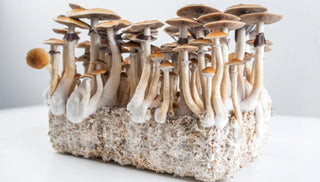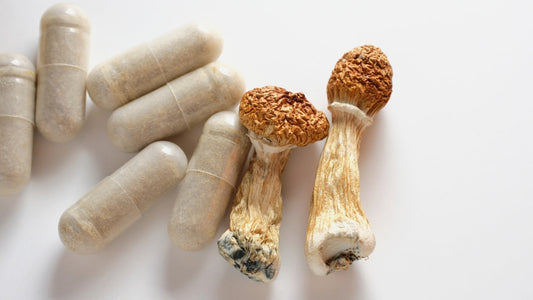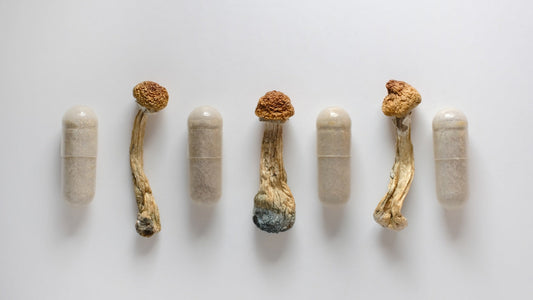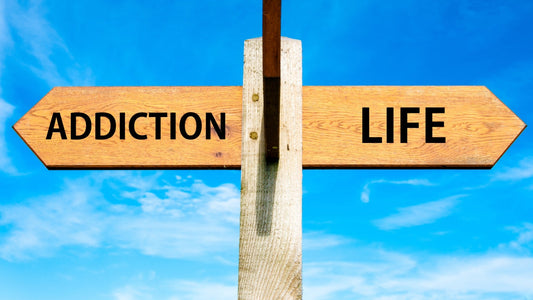Psychedelic mushrooms aren’t only about tiny “microdose” amounts. Around the world -- and increasingly in clinical settings -- people are taking psychedelic mushrooms at both microdoses (sub-perceptual) and normal doses (full "trip" experiences) to pursue mental health, sharp cognitive function, and personal growth goals.
In this article, we look at what people and researchers report about benefits associated with normal-dose, therapist-supported sessions and everyday microdosing routines. Throughout, we keep a balanced perspective: promising signals for psychedelic mushroom benefits exist, but evidence quality varies and safety, legality, and clinical oversight all must be considered. Let's get to it!
Key Takeaways
- Normal-dose psychedelic mushroom sessions can spark profound psychological experiences with lasting changes when paired with preparation and therapy.
- Microdosing mushrooms aims for gentle, functional nudges without overt intoxication while still supporting mental wellness benefits.
- Normal-dose psychedelic mushroom trials using psychotherapy show improvements for those with depression, end-of-life distress and certain addictions.
- Real-world cohorts report mood and daily functioning benefits, while blinded studies show strong placebo effects and mixed performance outcomes.
- We're focusing on Psilocybin mushrooms; separately, Amanita muscaria is another psychedelic mushroom, but it has some toxicity concerns.
- Important note: Not everyone benefits, difficult sessions happen, and supportive care is essential. Results depend on dose, set/setting, therapy and history.
- Laws vary widely; screening, supervision, and integration support are critical for normal-dose work, and careful self-monitoring is essential for any routine.
Disclaimer
This article is for educational purposes only and is not medical, psychiatric, legal, or professional advice. Psychedelic mushrooms are illegal in many jurisdictions; do not possess, use, or distribute them where prohibited. Potential risks include acute anxiety/panic, confusion, impaired judgment, nausea/headache, and rarely worsening of underlying mental health conditions. People with personal or family histories of psychosis, schizophrenia, or bipolar disorder (especially mania/hypomania), or other mental health concerns; significant cardiovascular disease, seizure disorders, glaucoma, or who are pregnant or nursing should avoid use. Psychedelics can interact with medications and other substances; never start, stop, or combine treatments without a doctor's guidance. Do not drive or perform safety-sensitive tasks while affected. If you have lawful access and are considering use, do so only under qualified clinical supervision.
What Counts as a “Psychedelic Mushroom”?
Psychedelic mushrooms are getting a lot of buzz these days. When it comes to psychedelic fungi, science is mostly focusing on psilocybin (a.k.a. "magic mushrooms") for its health benefits. However, Amanita muscaria (fly agaric) is another mushroom with psychedelic properties. We're only touching upon fly agaric; it is largely avoided in clinical settings due to its potential risks. More on these two:
- Psilocybin-containing mushrooms convert to psilocin in the body and primarily act at serotonin receptors involved in perception and cognition.
- Amanita muscaria (also called fly agaric) is psychoactive, though it does not supply psilocybin. Amanita muscaria behaves more like a sedative. It has toxicity risks and may be classified under poisonous mushrooms.
In this article, we are focusing on psilocybin psychedelic mushroom benefits as that is where most research is concentrated.
The big variable: Will psilocybin be taken at a normal dose or a microdose? Let's take a look at each approach's potential wellness benefits.
What Psychedelic “Benefits” May Look Like in Practice

Let's take a quick look at purported psychedelic mushroom benefits before we dig into the science. The following overview includes both research signals and anecdotal reports from psychedelic mushroom users and enthusiasts.
- Mood and outlook: reports of reduced rumination, renewed motivation, and a more balanced response to stressors.
- Connection and meaning: normal-dose sessions frequently surface insights about relationships, purpose, and values that can guide long-term change.
- Behavior change: with integration, people describe stepping into healthier routines -- movement, boundaries, reduced substance use, healthier sleep patterns. Discover today's top ultramodern sleep supplement
- Creativity and cognitive flexibility: both paths are linked anecdotally to fresh perspectives; evidence is stronger for subjective experience than for standardized creativity tests.
Normal-Dose Psychedelic Benefits: The Intense Path

What is a "Normal" or "therapeutic" dose of psilocybin? A common dried-mushroom range is about 1-3.5 g of dried magic mushrooms (roughly 10-30+ mg psilocybin equivalent). Clinical trials often use 20-30 mg of purified psilocybin.
Effects are unmistakably psychoactive: sensory enhancement, visual hallucinations, physical effects (coordination issues, queasiness, tremors, etc.) altered thinking and emotion, and sometimes a spiritual, mystical or emotionally cathartic experience.
Normal dosing of psilocybin is not advisable for days where you must function normally; it is best to carefully plan "set and setting" and schedule some recovery time. Normal psilocybin dosing is not a protocol where you can drive, work, and in some cases (depending on dose), even be walking around.
Onset of "normal dose" psilocybin effects takes about 30-90 minutes. The experience peaks around 2–3 hours. Total duration of a psilocybin "trip" is typically 4-8 hours with a possible afterglow carrying over into the next day.
Goals of normal-dose psychedelic therapy center on deep perspective shifts, relief of dysfunctional mood patterns, and helping with psychotherapy breakthroughs. Research is early, but some potential benefits of therapeutic psilocybin dosing include:
- Major depression (single 25-mg dose + therapy): One supported session produced a larger and faster drop in depression scores and better functioning than active placebo through 6 weeks -- suggesting meaningful short-term relief when paired with psychotherapy.(1)
- Treatment-resistant depression (phase 2b): A single 25-mg dose reduced depression more than a 1-mg control at 3 weeks (10 mg did not); some patients maintained response to 12 weeks -- supporting dose-response and short-term benefit.(2)
- Alcohol use disorder (psilocybin + psychotherapy): Two psilocybin sessions led to a robust decrease in heavy-drinking days versus active placebo plus identical therapy -- pointing to benefit for alcohol-related outcomes.(3) Find out about the mushrooms-addiction connection
- Cancer-related anxiety/depression (high-dose, therapist-supported): Single psilocybin sessions produced rapid, large, and sustained relief of anxiety and depressive symptoms, with improved quality of life for months.(4,5)
- Depression: psilocybin vs selective serotonin reuptake inhibitors: Psilocybin therapy was at least comparable to SSRI escitalopram on the primary outcome and outperformed it on several secondary measures (e.g., well-being, malaise) in a 6-week trial.(6)
- Major depression (randomized immediate vs delayed treatment): Two psilocybin sessions with therapy produced large, rapid, and sustained mood-supportive effects compared with delayed treatment, highlighting substantial short-term benefit.(7)
- Frontline clinician depression/burnout (single 25-mg dose + group therapy): Psilocybin produced a greater reduction in depression at 6 weeks than niacin placebo, with durable gains for some -- suggesting potential in high-stress, burnout-related depression.(8)
Keep in mind, although psilocybin has been used for centuries, research on its benefits is still early. "Citizen Science" and anecdotal reports play a big role in driving psychedelic therapy research. To summarize potential benefits observed in research, as well as anecdotal reports:
- Rapid shifts in depressive and anxiety symptoms for some participants, with benefits sometimes persisting for weeks to months when paired with therapy.
- End-of-life and existential distress relief, often linked to experiences of meaning, connectedness, and emotional processing.
- Substance-use outcomes: Early trials (psilocybin + therapy) suggest improvements in alcohol use disorder and smoking cessation.
- Psychological flexibility: People frequently describe seeing problems from new angles, expanding thought patterns, and reconnecting with personal values.
Scientific evidence for psychedelic mushroom benefits for depression is growing. Especially research in which psilocybin is paired with screening, preparation, and therapy. Typical risks include anxiety or panic during the peak, challenging emotions, nausea/headache; careful clinical oversight and support are important.
Microdosing Benefits: Smaller Steps, Everyday Context

What is a psilocybin microdose? When microdosing magic mushrooms, people typically take about 0.05-0.30 g of dried Psilocybe cubensis (about 0.5-3 mg psilocybin, though potency varies by species, batch, and prep).
The aim is sub-perceptual effects: a lighter mood, slightly easier task initiation, maybe a touch of creativity -- if you feel clearly “high,” it’s not a microdose.
Most users remain fully functional for work or school. Onset is about 20-60 minutes, with a minimal “peak,” and a gentle tail that’s often 3-5 hours. Common goals are subtle mood/focus support, habit momentum, and day-to-day creativity.
Evidence is mixed: lab and self-blinding studies show clear acute effects but inconsistent advantages over placebo, while observational cohorts report small mood gains.
- Double-blind lab microdosing (0.5 g, within-subject). Low doses produced clear effects and measurable brain changes, suggesting physiological impact -- yet they did not improve creativity, cognition, or well-being versus placebo.(9)
- Largest self-blinding microdosing RCT (about 4 weeks). Both microdose and placebo groups improved mood and well-being with no significant differences between them -- implying the perceived benefit may come from expectations.(10)
- 1-month real-world cohort (953 microdosers vs 180 controls). Microdosers reported small-moderate gains in mood and mental health, and older adults showed better finger-tap speed. Adding lion’s mane mushroom + niacin didn’t change mood outcomes overall.(11)
- Six-week daily tracking (n=98). Participants reported “good-day” lifts on dose days and small longer-term shifts (lower depression and stress, less distractibility), though carryover was limited and expectancy effects -- and a slight rise in neuroticism -- were noted.(12)
Discover more about microdosing benefits
Typical downsides include jitteriness, nausea, sleep disruption, or distractibility if the dose creeps up; some people also develop a psychological reliance on the routine.
Because tolerance builds quickly, schedules bake in off-days (e.g., one day on/two off or every other day) and periodic breaks. Set and setting still matter -- dose low on calm mornings, keep routines steady, and log outcomes.
Check out our educational resource on how to microdose mushrooms
Key takeaway: Microdosing uses very small, sub-perceptual amounts on a repeating schedule to pursue mood steadiness, focus, creativity, and habit momentum. Large naturalistic cohorts often show self-reported improvements over about a month; controlled lab studies confirm acute effects but find mixed advantages over placebo. Many users value microdosing’s compatibility with work and family life.
Risks, Side Effects and Concerns: Brief Overview

Psychedelic work isn’t risk-free. Above is pictured Fly Agaricus (Amanita muscaria) mushroom, a psychedelic mushroom with poisonous properties that has been identified as risky. Avoid it!
Normal-dose psilocybin, while not toxic, can still be emotionally intense or challenging.
Even microdosing can bring anxiety, GI upset, sleep disruption, or distractibility.
Tolerance can develop with frequent dosing. Potency varies by species and preparation, and misidentification/contamination are real hazards. Screening, support, and conservative, well-designed routines reduce (but do not eliminate) risks.
Plus: Legal and Clinical Reminder
Psychedelic mushrooms are illegal in many jurisdictions. Therapeutic use where lawful should involve qualified medical supervision, careful preparation, and post-session integration. Everyone should take great care when considering psychedelic therapy, especially those with mental illness concerns. This article is for educational purposes only and is not medical or legal advice.
Summary
Psychedelic mushrooms have emerged as a fascinating segment in the functional mushrooms space. They can be approached along a spectrum -- from microdosing aimed at day-to-day steadiness to normal-dose, therapist-supported sessions designed for deeper therapeutic work.
Scientific research is strongest for structured, clinically supported normal-dose protocols; microdosing shows intriguing, real-world signals that are limited by placebo effects.
Research-based potential benefits of psilocybin mushrooms center on mental health and cognitive function: Enhanced mood and creativity; reduced addiction-related behavior, help for post-traumatic stress disorder (PTSD) and obsessive compulsive disorder (OCD).
But the thing with psychedelic mushrooms (and other psychedelics) is, there may be other benefits that are impossible to quantify with science.
Whether taking a normal dose or microdose, many psilocybin users report profound spiritual experiences that seem to illuminate life with an afterglow that lasts days, weeks, or even months after the psychedelic session. And anecdotally, some people who microdose may even feel brain-boosting effects, not unlike today's top nootropic supplements: Greater clarity, focus and mental sharpness.
For anyone exploring the psychedelic drugs space legally, the most reliable gains tend to come from good screening, safe settings, skilled integration, and clear goals -- with humility about what we know and a commitment to ongoing, high-quality research.
References
- Raison, C. L., Sanacora, G., Woolley, J., Heinzerling, K., Dunlop, B. W., Brown, R. T., … Griffiths, R. R. (2023). Single-dose psilocybin treatment for major depressive disorder: A randomized clinical trial. JAMA, 330(9), 843–853. Link
- Goodwin, G. M., Aaronson, S. T., Alvarez, O., Arden, P. C., Bennett, J. C., Brunnauer, A., … Malievskaia, E. (2022). Single-dose psilocybin for a treatment-resistant episode of major depression. New England Journal of Medicine, 387(18), 1637–1648. Link
- Bogenschutz, M. P., Ross, S., Bhatt, S., … Trivedi, M. H. (2022). Percentage of heavy drinking days following psilocybin-assisted psychotherapy vs placebo in adults with alcohol use disorder: A randomized clinical trial. JAMA Psychiatry, 79(10), 953–962. Link
- Griffiths, R. R., Johnson, M. W., Carducci, M. A., … Klinedinst, M. A. (2016). Psilocybin produces substantial and sustained decreases in depression and anxiety in patients with life-threatening cancer: A randomized double-blind trial. Journal of Psychopharmacology, 30(12), 1181–1197. Link
- Ross, S., Bossis, A., Guss, J., … Schmidt, B. L. (2016). Rapid and sustained symptom reduction in anxiety and depression following psilocybin treatment in patients with life-threatening cancer: A randomized controlled trial. Journal of Psychopharmacology, 30(12), 1165–1180. Link
- Carhart-Harris, R. L., Giribaldi, B., Watts, R., … Nutt, D. J. (2021). Trial of psilocybin versus escitalopram for depression. New England Journal of Medicine, 384, 1402–1411. Link
- Davis, A. K., Barrett, F. S., May, D. G., … Griffiths, R. R. (2021). Effects of psilocybin-assisted therapy on major depressive disorder: A randomized clinical trial. JAMA Psychiatry, 78(5), 481–489. Link
- Back, A. L., Freeman-Young, T. K., Morgan, L., Gooley, T., Koenig, W., … Raison, C. L. (2024). Psilocybin therapy for clinicians with symptoms of depression from frontline care during the COVID-19 pandemic: A randomized clinical trial. JAMA Network Open, 7(12), e2449026. Link
- Cavanna, F., Muller, S., de la Fuente, L. A., Zamberlan, F., Palmucci, M., Janeckova, L., … Tagliazucchi, E. (2022). Microdosing with psilocybin mushrooms: A double-blind placebo-controlled study. Translational Psychiatry, 12, 307. Link.
- Szigeti, B., Kartner, L., Blemings, A., Rosas, F., Feilding, A., Nutt, D. J., Carhart-Harris, R. L., & Erritzoe, D. (2021). Self-blinding citizen science to explore psychedelic microdosing. eLife, 10, e62878. Link.
- Rootman, J. M., Kiraga, M., Kryskow, P., Harvey, K., Stamets, P., Santos-Brault, E., … Walsh, Z. (2022). Psilocybin microdosers demonstrate greater observed improvements in mood and mental health at one month relative to non-microdosing controls. Scientific Reports, 12, 11091. Link.
- Polito, V., & Stevenson, R. J. (2019). A systematic study of microdosing psychedelics. PLOS ONE, 14(2), e0211023. Link.



